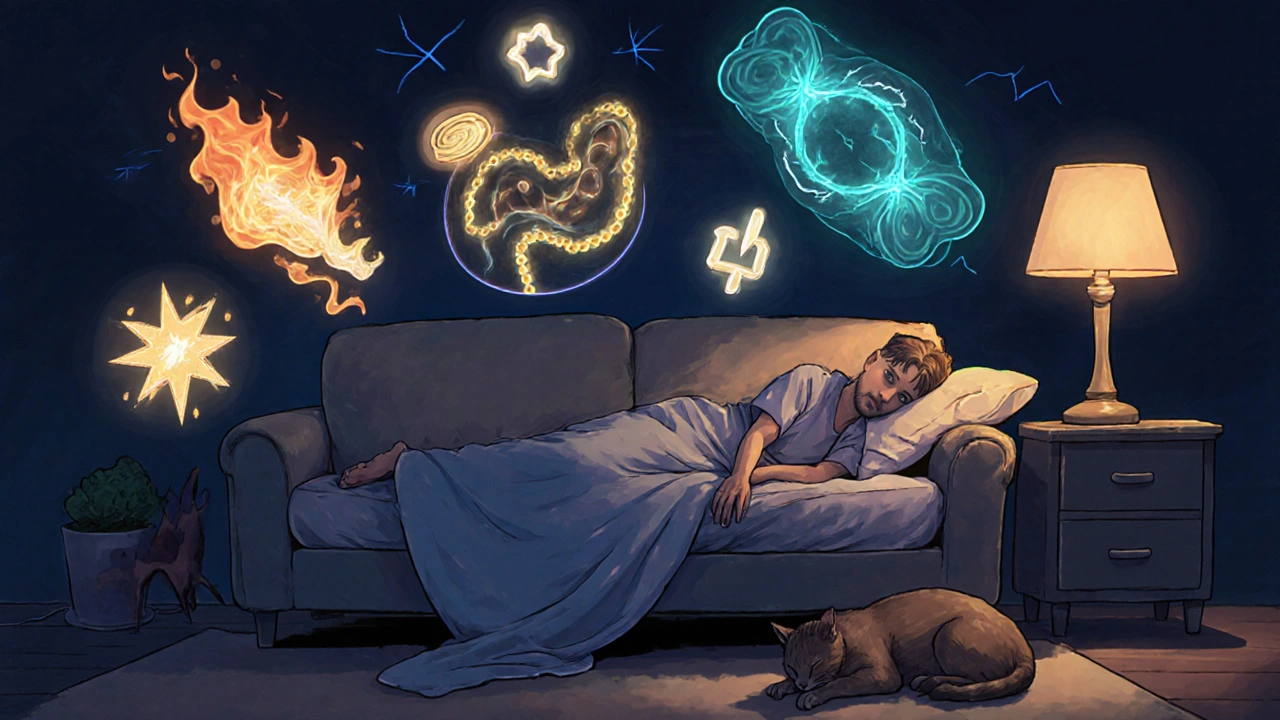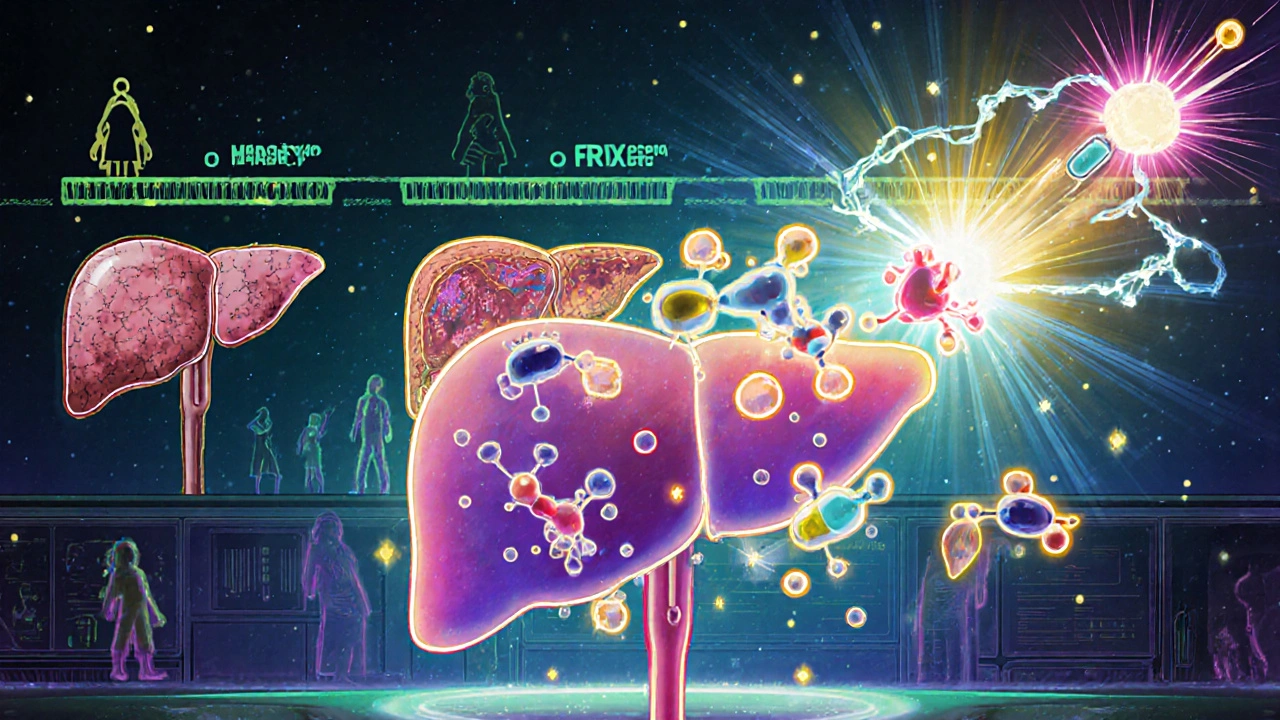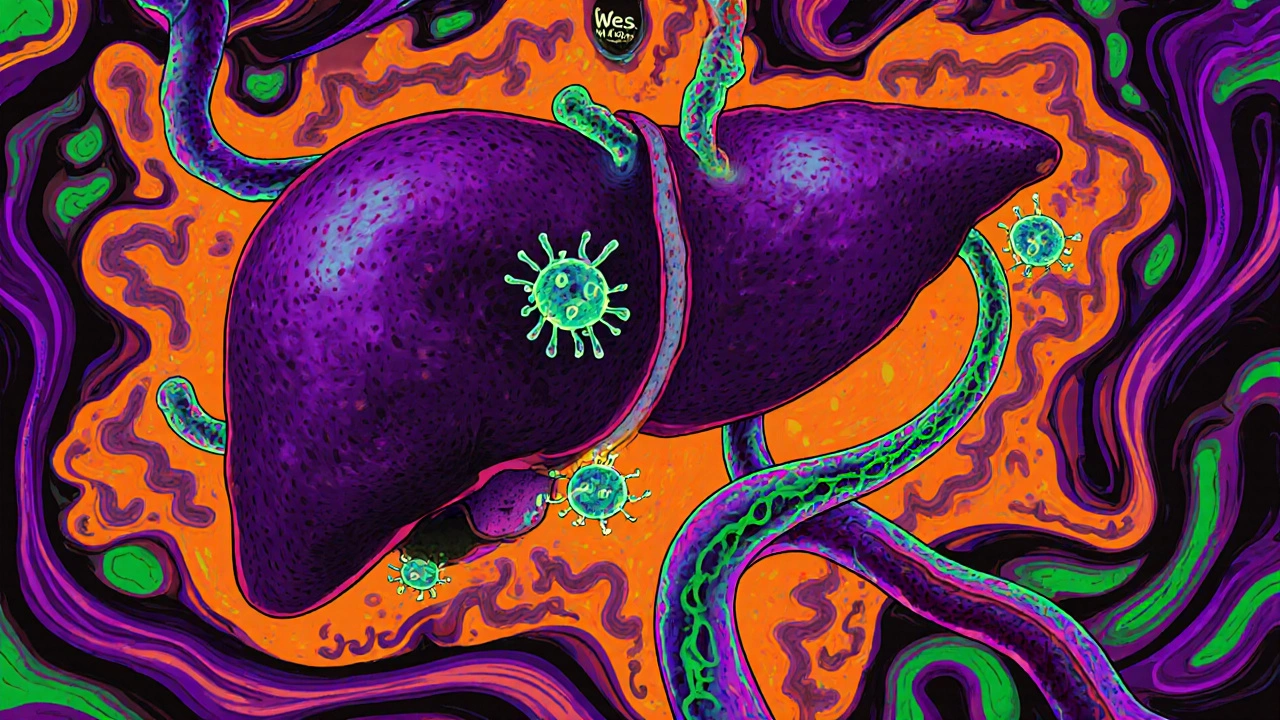Primary Sclerosing Cholangitis (PSC) isn’t something most people hear about until it hits close to home. It’s a rare, slow-burning disease that attacks the bile ducts inside and outside the liver, turning them into scar tissue over time. There’s no cure. No magic pill. And for many, it takes years just to get a diagnosis. But understanding what PSC really is - how it works, how it’s managed, and what’s on the horizon - can make all the difference in living with it.
What Exactly Happens in Your Liver With PSC?
Your liver makes bile, a fluid that helps digest fat. Bile travels out of the liver through a network of tubes called bile ducts. In PSC, those ducts become inflamed, swollen, and eventually scarred. The scarring narrows the ducts - sometimes down to less than 1.5mm wide - blocking bile from flowing properly. That’s called cholestasis. When bile backs up, it damages liver cells. Over time, this leads to fibrosis, then cirrhosis, and eventually liver failure.
Unlike other liver diseases like hepatitis or fatty liver, PSC doesn’t come from alcohol, viruses, or diet. It’s autoimmune - your immune system mistakenly attacks your own bile ducts. But why? Research points to a mix of genetics and gut health. People with PSC often have a genetic marker called HLA-B*08:01, which increases risk more than twofold. And nearly 70% also have ulcerative colitis, a type of inflammatory bowel disease. That link isn’t random. Scientists now believe bacteria or toxins leaking from a damaged gut trigger immune responses that target the bile ducts. This is called the gut-liver axis, and it’s central to how PSC develops.
Who Gets PSC - And Why Is It Often Missed?
PSC mostly affects men between 30 and 50. The ratio is about two men for every woman. It’s rare - about 1 in 100,000 people globally - but more common in Northern Europe. In Sweden, it’s around 6 in 100,000. Most cases are diagnosed in people of European descent, though it’s being recognized more in Asian populations too, often in milder forms.
Here’s the hard part: symptoms are vague. Fatigue? Common. Itchy skin? So is that. Right upper abdominal discomfort? Many brush it off as indigestion. Because of this, the average time from first symptoms to diagnosis is 2 to 5 years. Many patients go through multiple doctors, blood tests, and even ultrasounds before someone orders an MRCP - a special MRI scan that shows the bile ducts in detail. That’s the gold standard for diagnosis. Blood tests alone won’t cut it. Liver enzymes like ALP and GGT rise, but they can also be elevated in other conditions. Only imaging can confirm the classic beaded appearance of strictured bile ducts.
How Does PSC Progress? The Four Stages
PSC doesn’t jump straight to liver failure. It creeps forward in stages:
- Stage 1: Inflammation around the portal areas of the liver - no scarring yet.
- Stage 2: Fibrosis starts forming around the portal zones.
- Stage 3: Fibrosis spreads and connects across liver sections - bridging fibrosis.
- Stage 4: Cirrhosis. The liver is covered in scar tissue, nodules form, and function declines.
On average, it takes 12 to 15 years to reach cirrhosis after symptoms begin. But progression varies wildly. Some people stay stable for decades. Others decline faster. Symptomatic patients - those with itching, jaundice, or fatigue at diagnosis - have a 51% chance of surviving 10 years without a transplant. Asymptomatic patients do better: 77% survive a decade without needing a new liver.

Why There’s No Drug That Stops PSC (Yet)
For years, doctors prescribed ursodeoxycholic acid (UDCA) - a bile acid meant to improve flow. But multiple large studies proved it doesn’t improve survival. In fact, high doses (over 28 mg/kg/day) may increase the risk of complications. The European Association for the Study of the Liver (EASL) and the American Association for the Study of Liver Diseases (AASLD) now recommend against routine UDCA use.
There’s no approved drug to slow or reverse PSC. That’s why so many patients feel frustrated. In one survey, 74% said doctors had “nothing to offer” beyond symptom relief. But that’s changing. Several drugs are in late-stage trials:
- Obeticholic acid (OCA): A bile acid receptor agonist. In a 2023 trial, it lowered liver enzymes by 32% in 18 months. FDA approval is pending due to safety concerns.
- Cilofexor: A non-steroidal FXR agonist. Showed a 41% drop in ALP levels in phase 2 trials. Granted orphan drug status in Europe in early 2023.
- NorUDCA: A modified bile acid. Early results suggest it may reduce fibrosis and inflammation.
These drugs target the farnesoid X receptor (FXR) and peroxisome proliferator-activated receptor (PPAR) pathways - key players in bile flow and liver inflammation. Experts predict at least two disease-modifying therapies could be available within five years.
Managing Symptoms - Because Life Doesn’t Stop
Even without a cure, you can feel better. The big three symptoms are fatigue, itching, and pain.
Itching (pruritus) is often the worst. It’s not just skin-deep - patients describe it like it’s coming from inside their bones, especially at night. First-line treatments include:
- Rifampicin: Works in 50-60% of patients. Dose: 150-300 mg daily.
- Naltrexone: Low-dose (50 mg daily) helps if itching is tied to opioid receptors.
- Colesevelam: A bile acid binder. Take 1.89-3.78 g daily. Less effective than rifampicin but safer long-term.
Fatigue is relentless. No medication fixes it. But structured activity - even walking 20 minutes a day - helps. Sleep hygiene matters. Many patients benefit from cognitive behavioral therapy for fatigue.
Pain is usually mild and dull. If you get sudden fever, chills, or jaundice, it could be cholangitis - a dangerous infection in the bile ducts. That’s a medical emergency. Antibiotics and sometimes drainage are needed.

What You Must Do to Protect Your Liver
PSC doesn’t just hurt your liver - it increases cancer risk. About 1.5% of people with PSC develop cholangiocarcinoma (bile duct cancer) every year. That’s why monitoring is non-negotiable.
- Annual MRCP: Tracks duct changes. No radiation, no biopsy needed.
- Every 1-2 years: Colonoscopy. Because 60-80% have ulcerative colitis, and that raises colorectal cancer risk to 10-15% over a lifetime.
- Quarterly blood tests: Check ALT, AST, ALP, bilirubin, and vitamin levels.
- Check fat-soluble vitamins: Vitamins A, D, E, and K are poorly absorbed when bile flow is blocked. Deficiencies cause bone loss, night blindness, and bleeding risks. Supplement as needed.
Also, avoid alcohol. Don’t take unnecessary supplements. And get vaccinated - hepatitis A and B can be deadly if your liver is already damaged.
When Transplant Is the Only Option
When the liver fails, transplant is the only life-saving option. The good news? Survival rates are excellent. More than 80% of PSC patients are alive five years after transplant. Many return to full activity, work, and even sports.
But transplant isn’t a cure-all. PSC can come back in the new liver - though it’s slow. About 10-20% develop recurrent disease over 10 years. Still, for those with advanced cirrhosis, portal hypertension, or recurrent cholangitis, transplant is the best shot at a normal life.
Getting on the list requires a team - hepatologists, transplant surgeons, social workers, nutritionists. Most patients get care at academic centers, not community hospitals. In the U.S., 72% live within 100 miles of a PSC-specialized clinic. In rural Europe, that number drops to 35%.
Where Hope Is Growing - And How to Find It
Patients aren’t just waiting. Online communities like PSC Partners Seeking a Cure have over 3,000 members worldwide. They share stories, trial updates, and practical tips. One Reddit user wrote: “The itching is unbearable - it feels like it’s coming from my bones.” That’s the kind of raw honesty that helps others feel less alone.
Research funding is still tiny. The NIH spent $8.2 million on PSC in 2022. For fatty liver disease? $142 million. But momentum is building. With international registries, real-world data, and new drugs in phase 3 trials, the next decade could change everything. Experts predict disease-modifying therapies could reduce the need for transplants by 40% within ten years.
For now, the goal is simple: manage symptoms, prevent complications, stay informed, and connect with others who get it. You’re not alone. And science is catching up.
Is primary sclerosing cholangitis the same as primary biliary cholangitis?
No. While both affect bile ducts and cause liver damage, they’re different diseases. PSC involves both large and small bile ducts inside and outside the liver, often linked to ulcerative colitis. PBC mainly attacks small ducts inside the liver and is marked by anti-mitochondrial antibodies (AMA), which are positive in 95% of cases. PSC patients rarely have AMA but may test positive for p-ANCA in 20-50% of cases. The treatments and progression patterns also differ.
Can you live a normal life with PSC?
Yes - but it takes work. Many people live for decades without major issues, especially if diagnosed early and managed well. Fatigue and itching can be controlled with medication and lifestyle changes. Regular monitoring catches problems early. Staying active, eating well, avoiding alcohol, and connecting with specialists helps maintain quality of life. Transplant offers a near-normal lifespan for those who reach end-stage disease.
Why is PSC so hard to diagnose?
Because symptoms are vague - fatigue, itching, mild pain - and easily mistaken for other conditions. Blood tests show elevated liver enzymes, but those can be caused by many things. The only way to confirm PSC is with an MRCP scan, which shows the characteristic beaded pattern of narrowed bile ducts. Many patients wait years because doctors don’t think to order it unless they suspect PSC, which isn’t common.
Does PSC run in families?
It’s not inherited like a single-gene disorder, but genetics play a big role. If you have a close relative with PSC, your risk is higher. The strongest genetic link is the HLA-B*08:01 gene variant, which increases risk over twofold. It’s also common in families with inflammatory bowel disease. So if you have ulcerative colitis and a family history of liver disease, talk to your doctor about screening.
What’s the risk of liver cancer with PSC?
About 1.5% of people with PSC develop cholangiocarcinoma (bile duct cancer) each year. That’s 15 times higher than the general population. Once cancer develops, survival drops sharply - only 10-30% survive five years. That’s why annual MRCP scans and tumor marker tests (like CA 19-9) are critical. Early detection gives the best chance for surgery or transplant.
Are there any new treatments on the horizon?
Yes. Drugs targeting the FXR and PPAR pathways - like obeticholic acid, cilofexor, and norUDCA - are in late-stage trials. In 2023, obeticholic acid reduced liver enzymes by 32% in a major trial. Cilofexor lowered ALP by 41%. These aren’t cures yet, but they’re the first drugs to show real disease-modifying potential. Experts believe at least two new therapies could be approved within five years. Research funding is growing, and international registries are helping speed up progress.

swatantra kumar
Man, I just read this and I’m like… why isn’t this on every med school syllabus? 🤯 PSC is the silent ninja of liver diseases. I’ve got a cousin who got diagnosed after 4 years of ‘it’s just stress’ - now he’s on the transplant list. Hope those new drugs work. 🙏 #PSCWarrior
robert cardy solano
I’ve been living with this for 8 years. No cure, but I’ve learned to live with the itch. Rifampicin helps, but the fatigue? Nah. Walking 20 mins a day saved my sanity. Also, vitamin D supplements? Non-negotiable. The liver doesn’t care how hard you work - it just wants you to take care of it.
Pawan Jamwal
USA spends $142M on fatty liver? Pathetic. India has 1.4 billion people and we don’t even have a single PSC research center. Why are we letting Western pharma control the narrative? We need our own trials. Our Ayurveda could help - turmeric, neem, guduchi - they’ve been used for centuries! Stop relying on ‘FDA-approved’ magic pills and start looking at real medicine.
Bill Camp
I just got diagnosed last month. I cried for three days. Then I Googled ‘PSC’ and found this post. I didn’t know I was part of a club. A club no one wants to join. But I’m here now. And I’m not giving up. If one of these drugs works - even a little - I’m gonna scream it from the rooftops. I’ve got two kids. I’m not done yet.
Lemmy Coco
i read this and thought wow this is so detailed. i have psc and my dr never told me about the gut-liver axis. i had no idea my ibd was connected. also i didnt know about the vitamin thing. i think i have a deficency. gonna ask my dr about it. thanks for sharing. (sorry for typos)
rob lafata
You people are pathetic. You’re sitting around waiting for a drug like it’s Christmas. The liver doesn’t care about your feelings. You have a ticking time bomb inside you and you’re talking about ‘fatigue management’? Wake up. If you’re not on the transplant list by now, you’re already losing. And if you’re using ‘natural remedies’ - you’re just buying time until you die in agony. Stop romanticizing this. This isn’t a blog post. It’s a death sentence with a 15-year grace period.
serge jane
I think about PSC like a slow river carving stone. It doesn’t rage. It doesn’t shout. It just keeps flowing. Day after day. Year after year. And you don’t notice the erosion until the cliff is gone. We spend so much time fighting the symptoms - the itch, the fatigue - that we forget we’re fighting the silence. The silence of a system that doesn’t speak until it’s too late. Maybe the real cure isn’t a drug. Maybe it’s learning to listen before the stone breaks.
Nick Naylor
The data is unequivocal: PSC is an autoimmune disorder with a strong HLA-B*08:01 association, predominantly affecting males 30–50, with a 1.5% annual cholangiocarcinoma incidence. MRCP is the diagnostic gold standard. UDCA is contraindicated per EASL/AASLD guidelines. FXR agonists (OCA, cilofexor) demonstrate statistically significant ALP reduction. Transplant survival exceeds 80% at 5 years. Recurrence occurs in 10–20% at 10 years. Vitamin supplementation is mandatory. Alcohol is contraindicated. Colonoscopy every 1–2 years is non-negotiable. There is no room for anecdote. Only evidence.